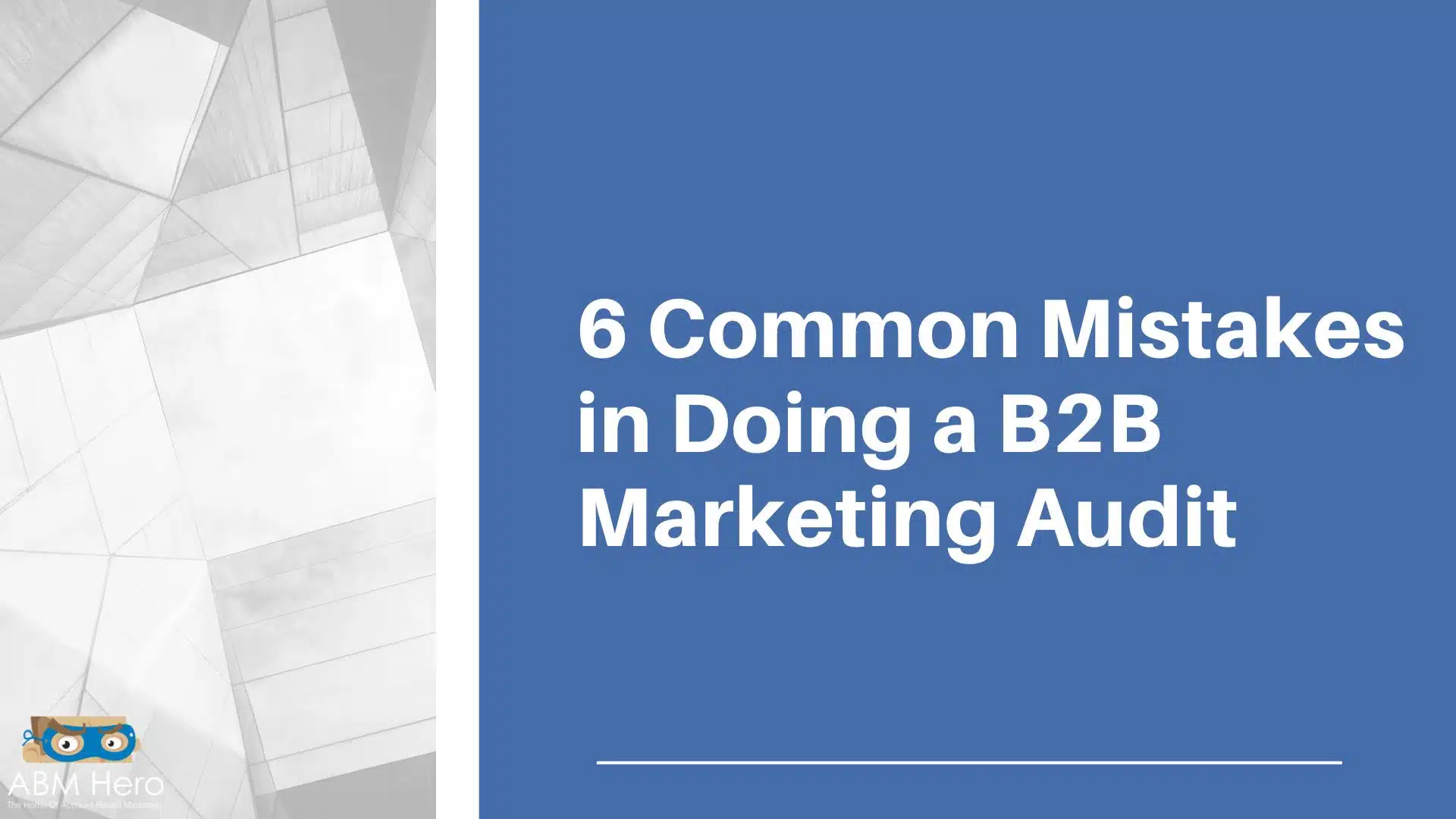B2B marketing audits are a critical part of any successful marketing strategy. They help identify areas of improvement and provide insight into how to improve your campaigns.
However, many B2B marketers must realize that their audits can quickly go wrong if not conducted appropriately.
In this article, we will discuss the common mistakes that B2B marketers make when conducting an audit and how to avoid them.
By understanding these mistakes and developing a comprehensive audit plan, you can ensure your B2B marketing audit succeeds.
Ignoring the Customer Journey
The customer journey is critical to any successful B2B marketing audit.
A comprehensive understanding of the customer journey enables marketers to identify areas in which their efforts may be falling short and areas where they may be able to make improvements and capitalize on opportunities.
By examining the customer journey, marketers can assess the effectiveness of their current strategies, determine where their efforts are having the most impact, and develop strategies to increase conversions and sales.
Marketers can uncover potential opportunities and identify where their current strategies may be inadequate.
Additionally, understanding the customer journey can help marketers identify areas where additional resources may be necessary to improve the customer experience and create a more personalized experience.
B2B marketers face unique obstacles when attempting to account for the customer’s journey in a marketing audit.
It is due to the complexity of the customer journey, which may include multiple touchpoints and channels and multiple departments and stakeholders.
Additionally, the customer journey is constantly changing as new technologies and trends in marketing are introduced.
It can make it difficult to accurately measure the impact of each marketing effort, as well as to identify potential areas of improvement.
Furthermore, due to the complexity of the customer journey, B2B marketers must account for the various customer segments and their individual preferences, which can be challenging to measure and track.
When conducting a B2B marketing audit, it is essential to consider the customer’s journey.
Doing so can ensure that the company’s marketing efforts are effective, efficient, and consistent.
A customer’s journey includes interactions with the company, from the initial discovery of the product or service to the ultimate purchase.
Understanding how customers interact with the company, their preferences, and how they make decisions is necessary.
Different channels and touchpoints should be evaluated to understand the customer’s journey.
It includes online and offline channels, such as website visits, email campaigns, and in-person sales calls. It is also essential to consider how customers interact with the company’s competitors.
Setting Aside Data-driven Insights
Data-driven insights have revolutionized the B2B marketing audit process by providing unprecedented detail and a more comprehensive and accurate picture of the effectiveness of a company’s marketing efforts.
By leveraging data collected from various sources, such as website analytics, customer feedback, and sales records, marketers can now better understand how their efforts impact their brand and ROI.
This level of detail allows for more effective strategic decision-making, as well as more effective targeting and segmentation of customer segments.
Furthermore, data-driven insights can also be used to identify potential areas for optimization, such as which channels are delivering the most leads and which campaigns are generating the highest ROI.
The omission of data-driven insights in a B2B marketing audit is common and can lead to negative consequences.
The underlying factors causing this omission are varied and complex. Still, they can generally be attributed to a lack of data access, insufficient data analysis training, a lack of organizational commitment to data-driven decision-making, and insufficient resources to undertake a comprehensive review.
When data-driven insights are present in a B2B marketing audit, organizations are likely to take advantage of crucial opportunities to improve their marketing strategies and have an accurate understanding of their current performance.
Moreover, an audit that needs to consider data-driven insights can lead to a misallocation of resources, resulting in decreased efficiency and effectiveness.
To ensure that data-driven insights are noticed during a marketing audit, businesses should use a mix of qualitative and quantitative methods.
Qualitative methods such as interviews, surveys, and focus groups can give businesses valuable insights into the customer experience and how they interact with the products and services offered.
Additionally, quantitative methods such as data analysis and statistical modeling can provide the business with a more quantitative understanding of the performance of its marketing efforts.
Not Learning from Competitor’s Strategies
It is essential to learn from competitors’ strategies in a b2b marketing audit, as a failure to do so can be detrimental to the overall success and sustainability of the business.
Competitive analysis is a vital part of any business audit, as it allows the organization to identify its competitors’ strengths and weaknesses and better understand the current market trends.
By utilizing competitors’ strategies, businesses can assess their performances compared to the competition and identify areas where they can improve their services or products.
Furthermore, understanding what competitors are doing can enable companies to develop marketing plans that are more effective and successful than those of their competitors.
Not Using the Right Metrics to Measure Success
Businesses must utilize the correct metrics when conducting a B2B marketing audit.
Businesses must assess the success of marketing strategies and campaigns utilizing the appropriate metrics to gauge the effectiveness of their efforts accurately.
The right metrics can lead to misinterpretations of results and accurate conclusions about the success of marketing initiatives, thus causing businesses to make decisions that may not be in their best interest.
Furthermore, the wrong metrics may lead to the misallocation of resources and adversely affect a business’s long-term performance.
Therefore, businesses must use the proper metrics when conducting a B2B marketing audit to ensure their efforts are successful and their resources are appropriately allocated.
When conducting a b2b marketing audit, it is vital to ensure that the appropriate metrics are being used.
The most effective way to do this is to evaluate the objectives of the business and determine which metrics will provide the most meaningful insights into the current state of the marketing strategy.
For example, if the objective is to increase brand awareness, metrics such as the number of views, impressions, and clicks can be used to measure progress. Other metrics, such as customer retention and engagement, should be considered if the goal is to increase customer loyalty.
Additionally, it is essential to consider the overall business goals and objectives to ensure that the chosen metrics are appropriate and relevant.
Not Understanding the Changing Landscape of B2B Marketing
When conducting a marketing audit, it is essential to have a comprehensive understanding of the ever-changing landscape of B2B marketing.
It is important to understand the many different aspects that come into play in this field, from the types of buyers to the various kinds of products and services being offered.
As the market continues to evolve and new technologies become available, it is crucial to recognize this impact on B2B marketing.
Furthermore, it is necessary to understand the strategies and tactics required to reach and engage with potential buyers, as well as the methods used to measure the success of campaigns.
Not Exploring New Technology and Tactics
The consequences of a business-to-business (B2B) company failing to explore new technologies and tactics can be dire.
In an ever-evolving global economic landscape, B2B companies must remain agile and open to new opportunities to stay competitive and ensure their business’s sustainability.
The company must explore new technologies and tactics to avoid missing out on potentially lucrative opportunities, especially those enabled by digital transformation.
Additionally, they need more exploration to stay ahead of the competition, which can lead to efficient processes that can ultimately cost the company time and money.
Lastly, the company must explore new technologies and tactics to avoid becoming obsolete.
B2B marketing endeavors often require a comprehensive evaluation of emerging technologies and tactics to achieve success.
To ensure that all available options are being considered, it is all-important to assess the current trends in the industry routinely and to remain aware of any new developments.
Additionally, it is beneficial to have conversations with industry experts and keep a finger on the market’s pulse. Researching the latest industry news can also help to identify potential opportunities.
Finally, having an open mind to new technologies and tactics and adequately testing them can provide valuable insight into how they can be applied to B2B marketing.
It is essential to conduct b2b marketing audits with diligence and due care, as the results of such an audit will be used to inform strategic choices. Nonetheless, mistakes can be made, which sometimes can be costly.
However, when mistakes are identified, it is necessary to analyze what went wrong and implement appropriate measures to prevent them from happening again.
With the right approach and knowledge of the common pitfalls that could occur during b2b marketing audits, businesses can avoid costly errors while reaping the rewards of a successful audit.





